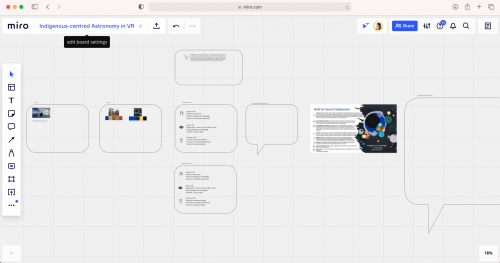
"Two things fill the mind with ever-increasing wonder and awe, the more often and the more intensely the mind of thought is drawn to them: the starry heavens above me and moral law within me." - Emannuel Kant
What sparked your curiousity about astronomy?
My data collection is starting with this question. As astronomers, researchers and dreamers tell me about what sparked their curiousity about astronomy, I hope to build these sparks into the experience. This VR experience is a record of our shared wonder at the starry heavens above in the hope this experience can inspire future scientists.
This project is an iterative exploration of the materialitiy of a planetarium inspired VR experience, based on my novice learnings of indigenous astronomy. Each sprint has a reflection activity so that the thoughts and emotions generated with use of the technology are built back into the experience (Barrett, 2007). Each phase will be creating an artefact that provides a measure of progress and a foundation for the next phase. The iterative form of this approach is strongly influenced by agile methodology commonly used in software development (Poppendiek, 2003); instead of working software being the only measure of progress, the creative artefact (Candy, 2006) from each sprint gives a measure of progress.
Each sprint has a reflection activity so that the thoughts and emotions generated with use of the technology are built back into the experience (Barrett, 2007). Each phase will be creating an artefact that provides a measure of progress and a foundation for the next phase. The iterative form of this approach is strongly influenced by agile methodology commonly used in software development (Poppendiek, 2003); instead of working software being the only measure of progress, the creative artefacts (Candy, 2006) from each sprint gives a measure of progress.
Lucas Zonotto, maker of Where Thoughts Go, talks about the shields people have when they walk into a VR experience. This project aims to take his advice on lowering our shields by designing for strong reactions and designing for playfulness. The design process will build on iterations of playtesting and redesign, when we find a feeling, we will try to amplify it by increasing physicality, give multi-sensorial feedback and emphasising agency.
This studio project is my work integrated learning to run a series of experiments on visualising and interacting with constellations in planetarium inspired VR experience. Researchers (Kirsting et al, n.d.) from the OZGrav project found "So to be able to not just look at something passively, but to be able to interact with it and see what happens, how it changes. That's a good side of VR.” My project stakeholders include University of Melbourne researchers who will be able to influence the prioritisation and planning of these experiments, the collaborative discussions will be mapped in a visual, digital whiteboard on the Miro platform.
Tim Ingold talks about the dynamics of social interaction where every living being is a line or a bundle of lines. The knots in between the lines are the entwining of our life lines securing the forms we make in entangling. These knotted lines can't be detached or reconfigured without loss, this is not a breaking but a casting off.
This project is experimenting with ways to communicate indigenous knowledge of astronomy through virtual reality in an educational context. Planetariums played a formative role for my own interest in astronomy: as a school student, repeated trips to Brisbane's planetarium sparked a curiousity about the science and wonder of our universe. The planetarium experience communicates scientific knowledge in different ways, visual-spatial people can get a sense of their location in space while sound communicated and engages our emotions to make information more memorable (Kovalenko, 2019). If education is not about an approved body of knowledge told to students, as Tim Ingold argues (Ingold, 2015 ), instead education is a process of leading novices into the world to learn and be taught by the world: this experience is designed to immerse the player in a universe centred on indigenous knowledge.
The first experiments are exploring ways that the oculus quest VR headset could enable player-storytellers to link a constellation to their spoken story. This will be a series of experiements to understand how hand tracking can enable interaction with stellar objects to play sounds.
But first, let's talk about hands. Joining hands is a ritual of social connection. Holding our hands to the sky is a human way of measuring space and place. And yet the VR hands in oculus quest feel disembodied, they look masuline to me, using the hand controllers doesn't tap into the controller capabilities of haptic feedback. As I check the movement of my hands, I clap to listen and look for the location of 'my' hands in the virtual space.
What lines can I trace in the sky with my hands? How are these lines joined together - is it a knot that eases and tightens tension between the lines? Is it a hand-hold, easy to join, easy to release?
References:
Barrett, E. (2007). Experiential learning in practice as research: context, method, knowledge. Journal of Visual Art Practice, 6(2), 115–124. https://doi.org/10.1386/jvap.6.2.115_1
Candy, L., Amitani, S., & Bilda, Z. (2006). Practice-led strategies for interactive art research. CoDesign, 2(4), 209–223. https://doi.org/10.1080/15710880601007994
Ingold, Tim. (2015, October 19). Abup talks - Tim Ingold - “The life of lines.”
Kersting, M., Steier, R., & Venville, G. (n.d.). Exploring participant engagement during an astrophysics virtual reality experience at a science festival. International Journal of Science Education. Part B. Communication and Public Engagement, ahead-of-print(ahead-of-print), 1–18. https://doi.org/10.1080/21548455.2020.1857458
Kovalenko, N. (2019). “Astronomy: Learning Theories Applicable for Education in Planetarium Environment.” EPJ Web of conferences 200 : 1014–. Web.
Poppendieck, M., & Poppendieck, T. (2003). Lean Software Development: An Agile Toolkit: An Agile Toolkit (1st edition). Addison-Wesley Professional.
Downloads:
-
Download File: 1615850916_miroboard-as-at-15-march-2021.png
About This Work
By Amanda Belton
Email Amanda Belton
Published On: 16/03/2021
